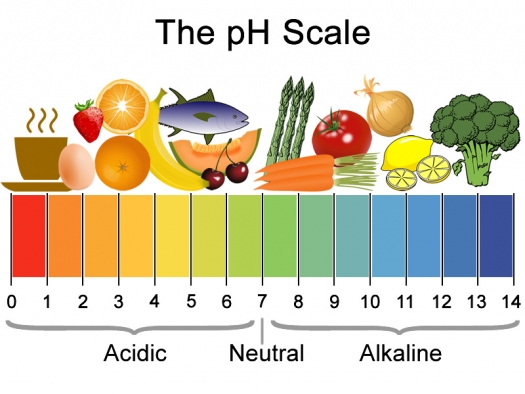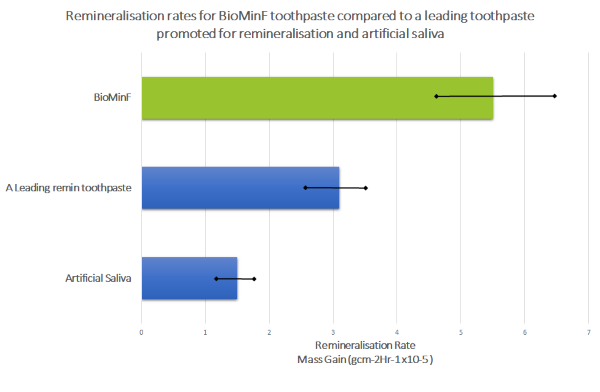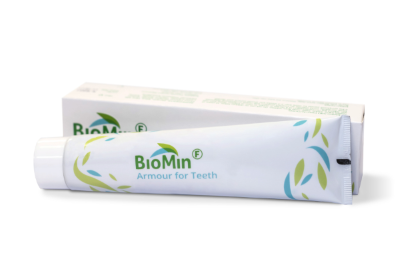Remineralising toothpaste – do homemade recipes really work?
Remineralisation and demineralisation are a natural process that affects the enamel (outer layer) of the tooth’s surface. The tooth’s enamel is the most mineralised part of the human body with about 98% of it is made up of a substance called hydroxy apatite, which consists mostly of phosphate and calcium. When acids come in contact with the tooth’s enamel, these can cause it to slowly dissolve. This is the process of demineralisation. Fortunately, there is a reversal of this process. Remineralisation can occur when the mouth becomes pH neutral. Saliva rich in calcium and phosphate creates apatite crystals which slowly repair the enamel.
When demineralisation rates are greater than remineralisation rates for extended periods, teeth will start to decay. Studies in the US have shown 79% of adults have moderate tooth decay, caused by juices and soft drinks#. A few early signs of demineralisation are white spots and some discolouration of the tooth’s surface. Left unchecked, these lead to the formation of cavities. The dental consensus is that once the enamel has been breached, or close to being breached then intervention in the form of fillings are required as the remineralisation process is not sufficient to repair a cavity. It is important to stop demineralisation early and drive the remineralisation process.
Acid in the mouth is the main cause of demineralisation. But where do acids come from?
The food you eat has the biggest impact on the acidity of your saliva. Some foods we eat are acidic enough to start dissolving the tooths surface. We all think of the culprit foods to be soft drink (cola is the worst), juices and lollies. However, common foods like wine, nuts, wheat, pork and processed foods are also major contributors. Then there are sugars and carbohydrates we eat. Bacteria on the tooths surface consume the sugars and output acids on to the tooth’s surface.

Dentists generally agree that the first step to maintaining healthy teeth is having a healthy diet – a diet low in sugars and processed foods, but high in essential minerals. Numerous highly ranked articles using Google search on “remineralisation” discuss natural ways to naturally remineralise teeth and avoid demineralisation. Many of these articles reference work undertaken by Dr Weston. He proposed that phytic acids found in many foods were the greatest cause of decay. Numerous related articles and blogs discuss drastically reducing or eliminating specific foods or food groups known to have medium to high levels of phytic acids in an attempt to minimise demineralisation rates. Many health commentators advocate well-balanced diets as being important. Removing key foods or food groups can have other negative impacts on overall health and wellbeing, and is contradictory to dietary advice given by healthcare professionals. With today’s eating habits it is difficult for most people to maintain a diet low in sugars and phytic acids long term. Combing a healthy varied diet with a habitual teeth cleaning regimen (twice daily tooth brushing) using a quality scientifically proven remineralising toothpaste is a more balanced effective solution.
Calcium and phosphate are essential for remineralisation, with fluoride being a catalyst. Researchers have spent decades trying to solve the complexity of adding bioavailable phosphate and calcium to toothpaste, to enhance remineralisation rates. Homemade formulations on the web do appear to have merit and can potentially drive remineralisation rates, however, data is lacking as to how much the remineralisation rate is increased and for how long. Some remineralisation formulations may not be delivering any incremental benefits over natural remineralisation at all, and may lead users into a false sense of security.

Optimal remineralization depends on the enamel surface’s being exposed to low concentrations of calcium, phosphate and fluoride for prolonged periods.
Prof: Garcia-Godoy
Editor: American Journal of Dentistry
BioMinF, a new remineralising toothpaste, based on 10 years of research conducted at Queen Mary University of London. BioMin F has a unique slow release patented formula, that effectively delivers essential calcium and phosphate to the tooth’s surface. As acids levels increase BioMin F, releases additional calcium and phosphate ions and helps neutralise the acids. Effectively stopping demineralisation and promoting remineralisation.
BioMin F‘s slow release formula enables BioMinF to use low doses of fluoride to drive the remineralisation rate. The levels of fluoride in BioMinF are comparable to those found in children’s toothpaste. Therefore, BioMinF can be used by all members of the family from 6 years onwards.
BioMinC a non-fluoride formula that will be available in 2018.

#Okunseri C, Wong MC, Yau DT, McGrath C, Szabo A. The relationship between consumption of beverages and tooth wear among adults in the United States. J Public Health Dent. 2015;75(4):274–281.
